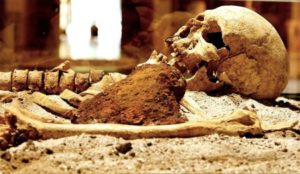
It must have been a thrill when the discoverers first realized that what they had uncovered in a barn in northwestern Pennsylvania in the 1980’s was the long-lost 541-page original manuscript of Bram Stoker’s famous classic novel, Dracula. Purchased later by Microsoft billionaire Paul Allen, the manuscript now rests in his personal library. Years later, another thinner, unmarked book was finally recognized for what it was on a shelf in Stoker’s grandson’s home—it was Stoker’s private journal, where he entered some of his first thoughts while imagining his legendary story of his Count Dracula character.
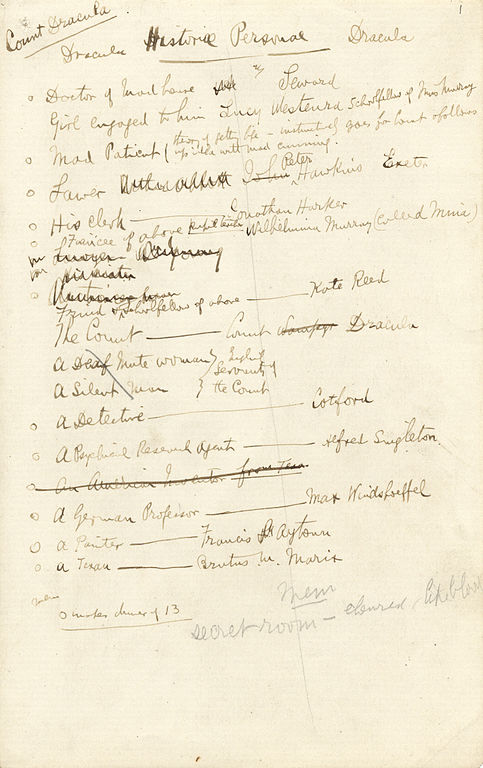 There is something of a popular draw to Stoker’s creation, and numbers tell it: Most recently, a first edition copy of Stoker’s Dracula, signed with the words “…. with Uncle Bram’s love 15 July 1897”, sold for $46,000 on January 31, 2013 at auction in the U.K. It was inscribed to the novelist and playwright Lucy Clifford, who was an acquaintance of Stoker and known for her circle of famous literary friends. Sold at a 190% increase over the estimated selling price, a similar edition sold just two years earlier at Christie’s for $27,258, marking a noticeable leap in value. In addition, the Rosenbach Museum in Philadelphia boasts a collection of Stoker’s original hand-written working notes (see sample left), grist that eventually found its way into his signature work. The museum now offers “hands-on” tours to an eager general public for an up-close and personal view of the documents.
There is something of a popular draw to Stoker’s creation, and numbers tell it: Most recently, a first edition copy of Stoker’s Dracula, signed with the words “…. with Uncle Bram’s love 15 July 1897”, sold for $46,000 on January 31, 2013 at auction in the U.K. It was inscribed to the novelist and playwright Lucy Clifford, who was an acquaintance of Stoker and known for her circle of famous literary friends. Sold at a 190% increase over the estimated selling price, a similar edition sold just two years earlier at Christie’s for $27,258, marking a noticeable leap in value. In addition, the Rosenbach Museum in Philadelphia boasts a collection of Stoker’s original hand-written working notes (see sample left), grist that eventually found its way into his signature work. The museum now offers “hands-on” tours to an eager general public for an up-close and personal view of the documents.
Some scholarship and historicity hovers beneath the resurging popularity of Dracula and the macabre, exotic fictional vampiric population to which he belongs. Stoker based much of his creation on seven years of research in Europe, where he established contacts and collected information about folklore and stories related to vampires, a significant mythic element of central and eastern European, especially Slavic, cultures. Historical players and events certainly played a major role in this—the 15th century Prince of Wallachia, Vlad (the “Impaler”) III of the House of Drăculești , for example, is known to have been the inspiration behind the character of Stoker’s Count Dracula.
__________________________________________
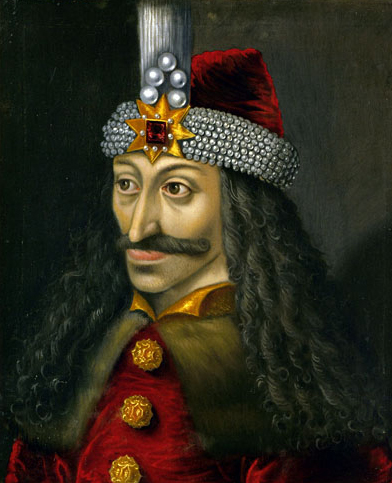 Portrait painting of Vlad the Impaler. Wikimedia Commons
Portrait painting of Vlad the Impaler. Wikimedia Commons
__________________________________________
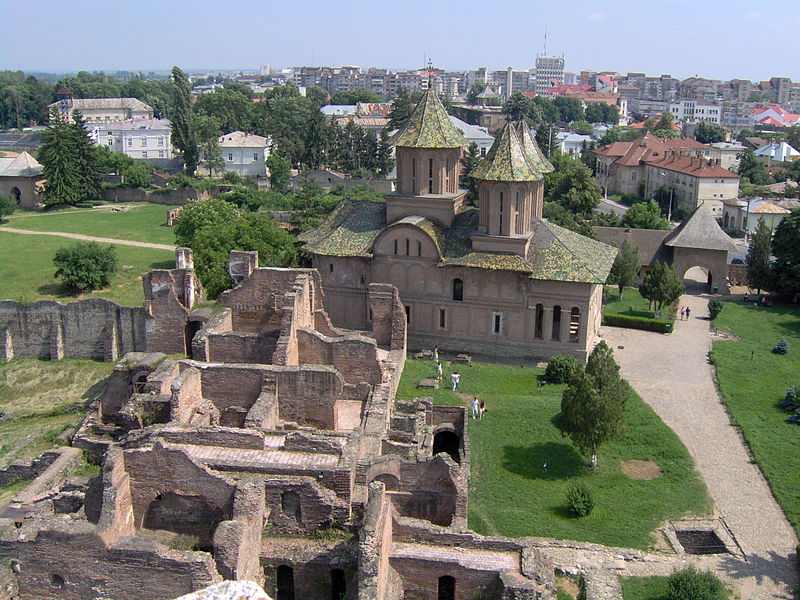 The remains of the castle of Vlad (the ‘Impaler’) Tepes in Romania. Wikimedia Commons
The remains of the castle of Vlad (the ‘Impaler’) Tepes in Romania. Wikimedia Commons
___________________________________________
But more fascinating still has been the evidence that archaeologists have uncovered in recent years, shedding light on the culture of vampire belief within the context of old European mythology and religious practice and Christian cultural notions of how communities and individuals addressed the presence, or potential presence, of ‘evil’ or ‘dark’ forces in their midst.
‘Vampire’ Archaeology
Archaeologists and other scientists who have exhumed the medieval and post-medieval skeletal remains of individuals in cemeteries across Europe in the course of their research have long known about burials of individuals who were thought to be potential ‘vampires’, or the ‘undead’. They know this by the peculiar features associated with the skeletal remains within the graves, objects such as sickles placed across the bodies, large stones placed over the neck or under the chins, iron bars or ‘stakes’ inserted through the chest area, or bricks or stones inserted within the cavity between the mandible and the cranium (the mouth). These have been considered indicators of apotropaic burial practices, or bodily treatments to the deceased within their coffins or graves designed to prevent them from returning to life and rising out of their graves to haunt, kill or eat the living. Only a minority of burials across Europe have exhibited these characteristics, but they have been observed in locations ranging from the British Isles in the north to Greece and Italy in the south.
Most recently, beginning in 2008, excavations carried out by an international team at the ‘Drawsko 1’ post-medieval cemetery site in northwestern Poland revealed six unusual graves, with skeletal remains dated to the 17th – 18th century showing sickles across the bodies or large rocks under the chins of select individuals, scattered among hundreds of normal burials. The researchers at the site have interpreted these to be apotropaic burials. “In Polish folklore……the soul and the body are distinct entities that separate upon a person’s death,” write Lesley A. Gregoricka of the University of South Alabama and colleagues in the report. “Souls, the majority of which are harmless, leave the body and continue to inhabit the earth for 40 days after death. However, a small minority of these souls were seen as a direct threat to the living and at risk of becoming a vampire, particularly those who were marginalized in life for having an unusual physical appearance, practicing witchcraft, perishing first during an epidemic, committing suicide, being unbaptized or born out of wedlock, or being an outsider to the community.”*
So what was it about these particular remains that could give clues about why they were treated this way? Determining ‘outsider’ status, one of the factors influencing the historical community perceptions related to potential vampirism, could be scientifically tested, and to this end, Gregoricka and her colleagues analyzed the remains of 60 of the total of 285 buried skeletal remains unearthed in the excavations, including those of five of the six “special” or deviant, apotropaic, burials. They did this by using radiometric strontium isotope analysis of dental enamel samples. This research methodology is useful because strontium isotopes are absorbed by the flora and fauna of local ecosystems (which include humans) through the weathering or breakdown of bedrock into the soils and groundwater. “Because strontium is structurally similar to calcium, as humans consume these plants and animals, small amounts of strontium absorbed by the intestines substitute for calcium in the formation of enamel and bone hydroxyapatite,” wrote Gregoricka, et al. in the report. “Strontium uptake into the human skeleton is primarily determined by these consumed foods, and because the 87Sr/86Sr ratios within these products are a direct reflection of the distinct isotopic composition of a particular region’s underlying geology, biogeochemical signatures in human dental enamel (which form only during childhood) offer a useful means of evaluating childhood geographic residence and mobility in the past.”* Powder samples of the tooth enamel were carefully removed using a fine Dremel tool for drilling, then painstakingly and methodically prepared and analyzed using time-tested methodologies at the University of North Carolina at Chapel Hill Isotope Geochemistry Laboratory.
_______________________________________
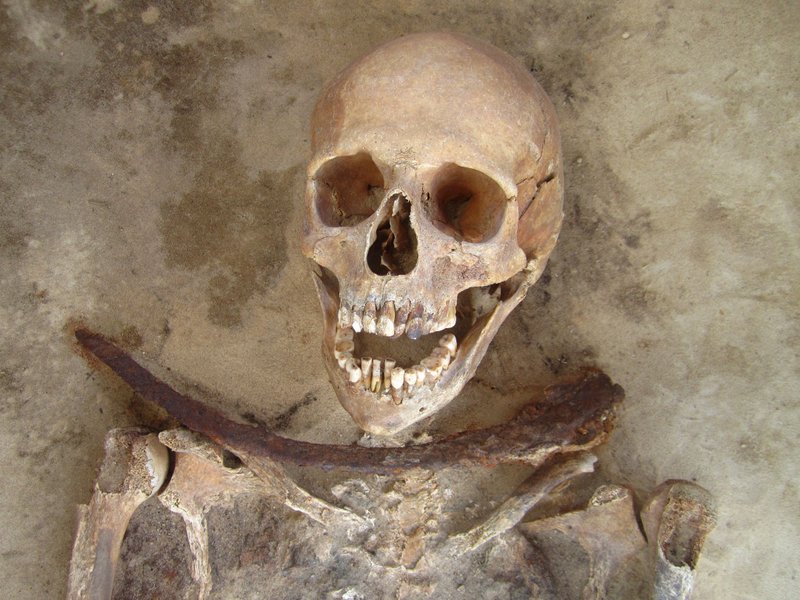 Individual 49/2012 (30-39 year old female) from the Drawsko 1 cemetery is shown with a sickle placed across the neck. Courtesy Amy Scott
Individual 49/2012 (30-39 year old female) from the Drawsko 1 cemetery is shown with a sickle placed across the neck. Courtesy Amy Scott
______________________________________
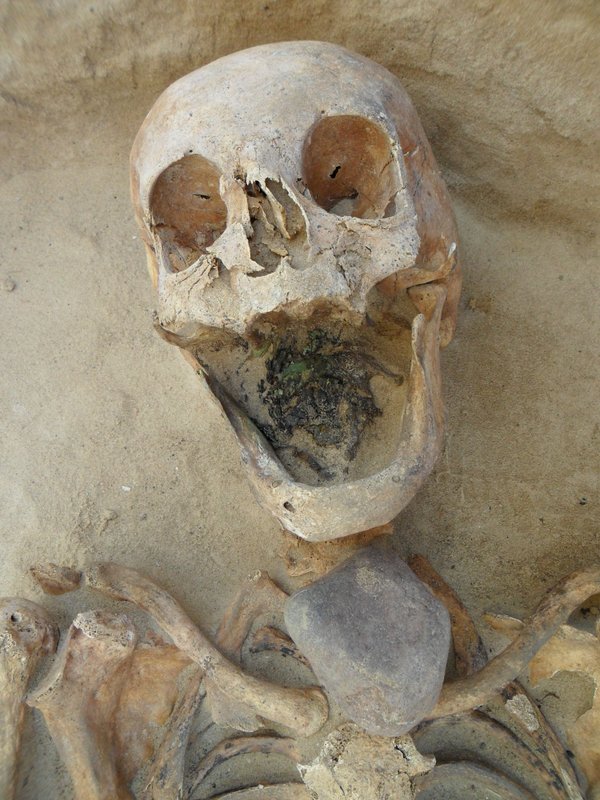 Individual 60/2010 (60+ year old female) from the Drawsko 1 cemetery is shown with a stone placed directly on top of the throat. Courtesy Gregoricka et al.
Individual 60/2010 (60+ year old female) from the Drawsko 1 cemetery is shown with a stone placed directly on top of the throat. Courtesy Gregoricka et al.
_______________________________________
The team’s conclusion: The ‘vampires’ were local. They did not immigrate into the community from the outside, often cited historically by residents of communities during the 17th and 18th centuries as a reason for the introduction of evil elements into the social structure. The data thus indicated that they had to be perceived with suspicion in some other way. The study authors suggest one alternate explanation could be related to the cholera epidemics in Eastern Europe during the 17th century. “People of the post-medieval period did not understand how disease was spread, and rather than a scientific explanation for these epidemics, cholera and the deaths that resulted from it were explained by the supernatural – in this case, vampires,” said Dr. Gregoricka. “Historic records describe multiple cholera epidemics that swept through Poland throughout the 17th century as a result of contaminated water……. the unusual characteristics of the Drawsko 1 cemetery – including the absence of a church (from excavations to date), the seemingly random placement of multiple overlapping graves, and poorly-fitted coffins (perhaps from rushed interment) – have hinted that the site may represent an epidemic burial ground resulting from a cholera outbreak.”*
There have been other apotropaic burial cases explained within plague-related contexts. In one instance reported in 2009, for example, Italian anthropologist Matteo Borrini of the University of Florence unearthed a curious skeleton at a mass grave site on the Venetian island of Lazarretto Nuovo. Discovered among the corpses of victims of the 1576 Venetian plague, it was that of an adult female with a brick that had been forcefully jammed into her mouth after death, likely by gravediggers during burial. Borrini explained this as evidence of the folk tradition of placing a brick or stone between the jaws of a deceased person suspected of becoming a vampire to prevent the ‘undead’ person from feeding on living individuals, thought during medieval times to be the cause of the spread of plagues like the Black Death. The plagues of Europe between the 14th and 18th centuries in part catalyzed a belief in vampires, primarily because gravediggers reopening the mass graves would periodically encounter decomposing bodies bloated by gas, hair still growing, and blood around their mouths. In addition, the shrouds that covered their faces were often more decayed in the mouth area because of bacteria, exposing the corpse’s teeth and creating the illusion of ‘shroud-eating’ vampires. These ‘undead’, according to medieval religious and medical texts, were thought to spread disease such as the Black Plague by sucking the blood from corpses to acquire the energy needed to go on living. “To kill the vampire you had to remove the shroud from its mouth, which was its food like the milk of a child, and put something uneatable in there,” Borrini told Daily Mail in 2012.**
But the Drawsko 1 cemetery researchers note other factors that could cast some doubt on the cholera epidemic suggestion, not the least of which revolves around the nature of the disease. “Because cholera kills quickly and does not leave behind visible markers on the skeleton,” write Gregoricka, et al., “it is unclear if this is the case at Drawsko.”*
As fascinating as these unusual burials may be, the statement mentioned above by Gregoricka and others serves to remind us of the uncertainty surrounding archaeological encounters like the Drawsko and Lazarretto Nuovo cases. David Barrowclough, Fellow and Director of Studies in Archaeology at Wolfson College, University of Cambridge, suggests the need for caution by scholars when interpreting their finds related to unusual, or ‘deviant’ burials. “Whilst it is found that there was a widespread belief in vampires across Europe, it is argued that it is difficult to make absolute claims for ‘vampire’ burials on archaeological grounds as in most cases there are alternate and equally compelling interpretations of the data,” he argues in a recent paper.*** Barrowclough cites a number of examples where alternate explanations, such as punishments for criminal acts, could be equally applicable. “In 2008, for example, archaeologists found a 4,000-year-old grave in Mikulovice in the Czech Republic where the skeleton had been weighed down at the head and the chest by two large stones. Had this skeleton been only four- or five-hundred years old it would no doubt have been claimed as ‘vampiric’……We need to beware presuming that all such unconventional, ‘deviant’, burials result from a fear of vampires. The unusual mortuary practices…..including staking, decapitation and covering with stones are noteworthy, but quite often they may be better explained as punishments for criminals, suicides, plague carriers or even witches rather than suspected vampires.”***
_____________________________________
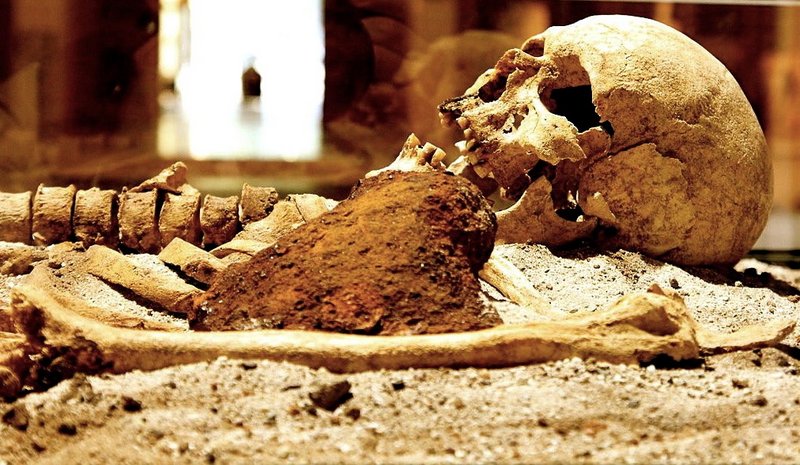 Above and below: One of two 14th century deviant burial skeletons exhumed near the Bulgarian Black Sea town of Sozopol. This one, according to archaeologist Dimitar Nedev, had a ploughshare-like object driven through the left side of the rib cage. The other had a metal object driven into the solar plexis. Nedev interpreted the skeletons as those of individuals who had been staked after death to prevent them from returning out of the grave as the ‘undead’. These are said to be examples of about one hundred such burials uncovered throughout Bulgaria. Bin im Garten, Wikimedia Commons
Above and below: One of two 14th century deviant burial skeletons exhumed near the Bulgarian Black Sea town of Sozopol. This one, according to archaeologist Dimitar Nedev, had a ploughshare-like object driven through the left side of the rib cage. The other had a metal object driven into the solar plexis. Nedev interpreted the skeletons as those of individuals who had been staked after death to prevent them from returning out of the grave as the ‘undead’. These are said to be examples of about one hundred such burials uncovered throughout Bulgaria. Bin im Garten, Wikimedia Commons
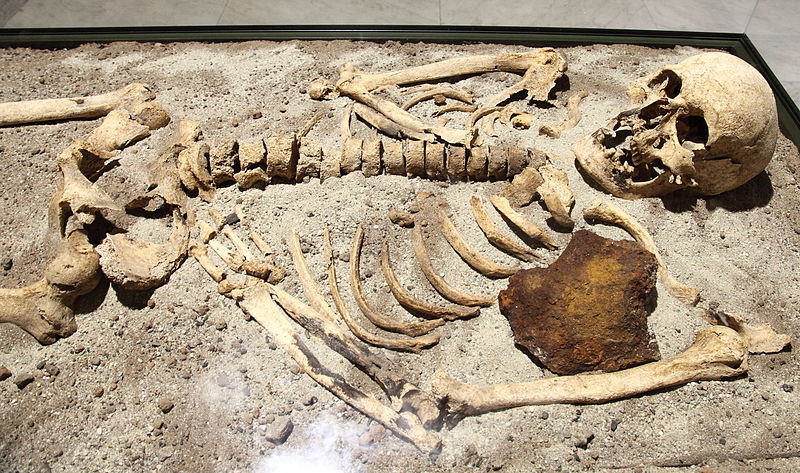 ______________________________________________
______________________________________________
Vampires and witches aside, however, studies like that undertaken by Gregoricka and her colleagues have and will continue to make a valuable contribution to the ongoing research on interpreting and understanding deviant burials and what they say about their historical and cultural contexts. They also serve to add to or confirm the utility of the tools used for investigating such burials, and burials in general.
“Strontium isotope data from the individuals interred at the cemetery at Drawsko provide new bioarchaeological perspectives into deviant burials and the motivations behind these unusual inhumation techniques,” wrote Gregoricka, et al. in the concluding remarks of their report. “Moreover, this biogeochemical analysis highlights the complexities of examining social identity in the past, and how the construction of identity may be intertwined with biological processes contributing to the makeup of skeletal tissues.”*
Stay tuned, hint Gregoricka and her colleagues. There is much more to come.
_______________________________________________
*Gregoricka LA, Betsinger TK, Scott AB, Polcyn M (2014) Apotropaic Practices and the Undead: A Biogeochemical Assessment of Deviant Burials in Post-Medieval Poland. PLoS ONE 9(11): e113564. doi:10.1371/journal.pone.0113564
**Vampires of Venice: Bricks and bones show how scared the Medieval world was of the undead, be Eddie Wrenn for MailOnline, June 1, 2012.
***Barrowclaough, D., Time to Slay Vampire Burials? The Archaeological and Historical Evidence of Vampires in Europe. First published: 19.10.2014. Cambridge: Red Dagger Press
____________________________________________
Just released!
The special new premium quality print edition of Popular Archaeology Magazine. A beautiful volume for the coffee table.
Travel and learn with Far Horizons.
On the go? Get the smartphone version of Popular Archaeology as an app or as an ebook.
Popular Archaeology’s annual Discovery Edition eBook is a selection of the best stories published in Popular Archaeology Magazine in past issues, with an emphasis on some of the most significant, groundbreaking, or fascinating discoveries in the fields of archaeology and paleoanthropology and related fields. At least some of the articles have been updated or revised specifically for the Discovery edition. We can confidently say that there is no other single issue of an archaeology-related magazine, paper print or online, that contains as much major feature article content as this one. The latest issue, volume 2, has just been released. Go to the Discovery edition page for more information.






